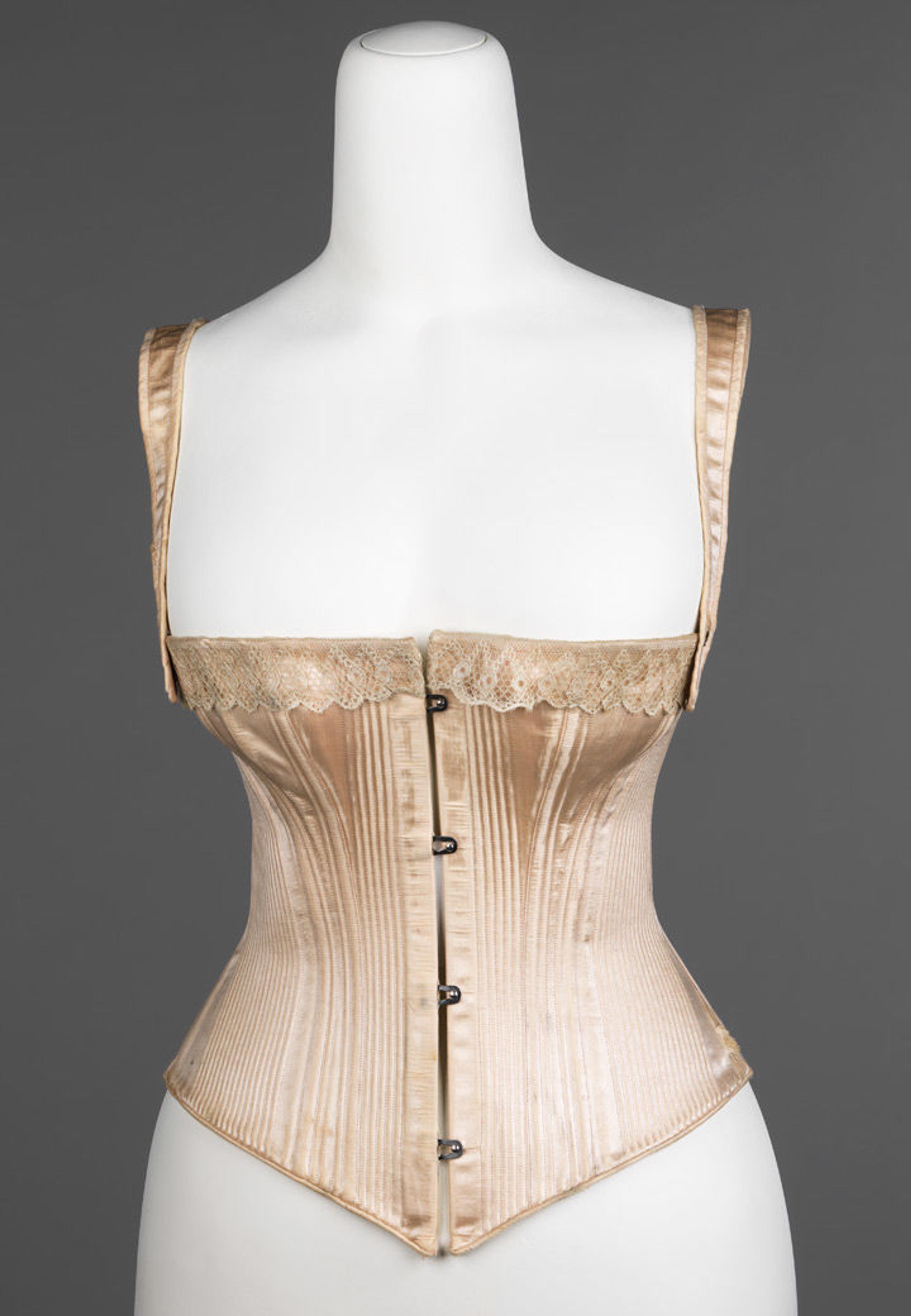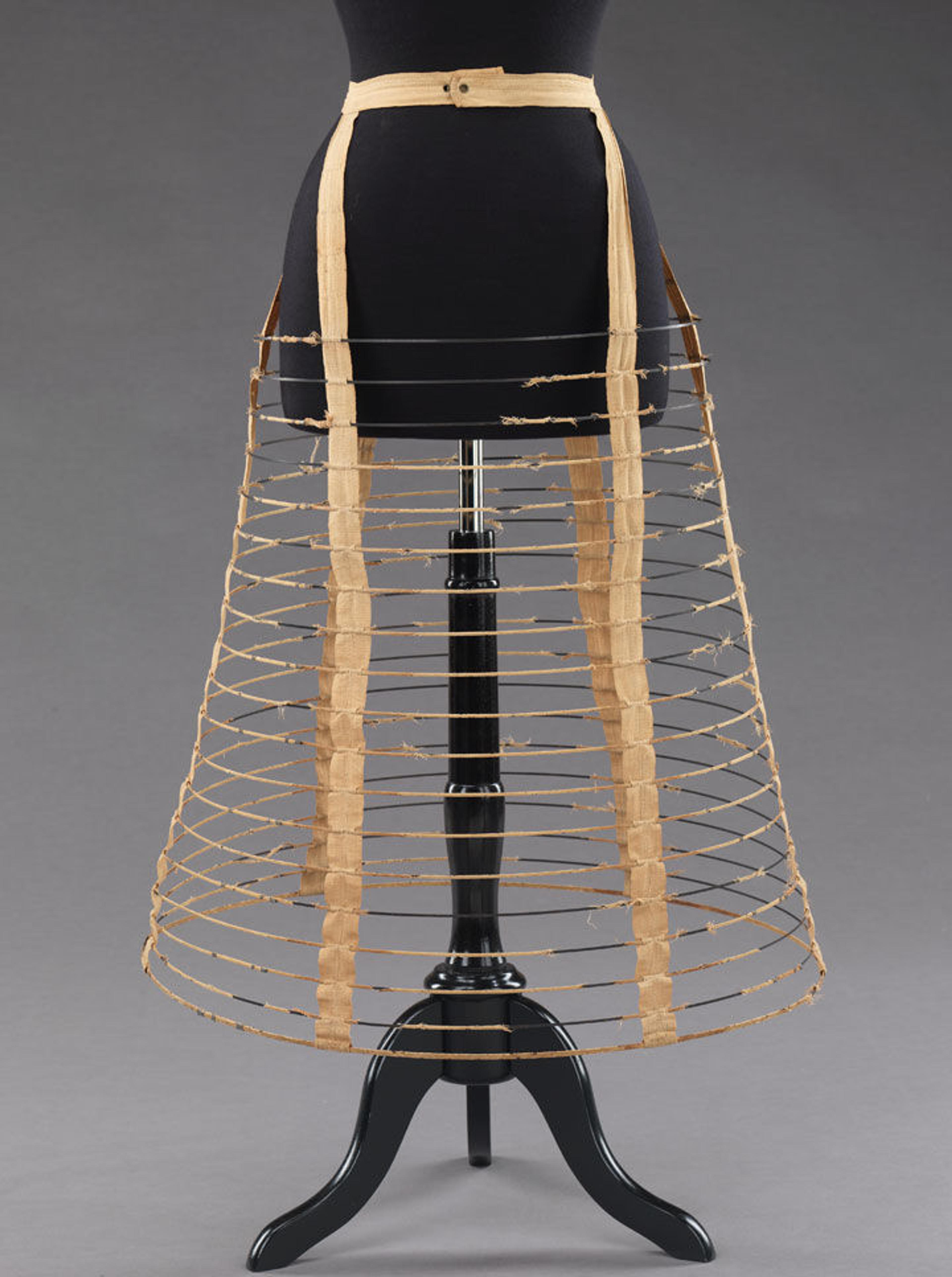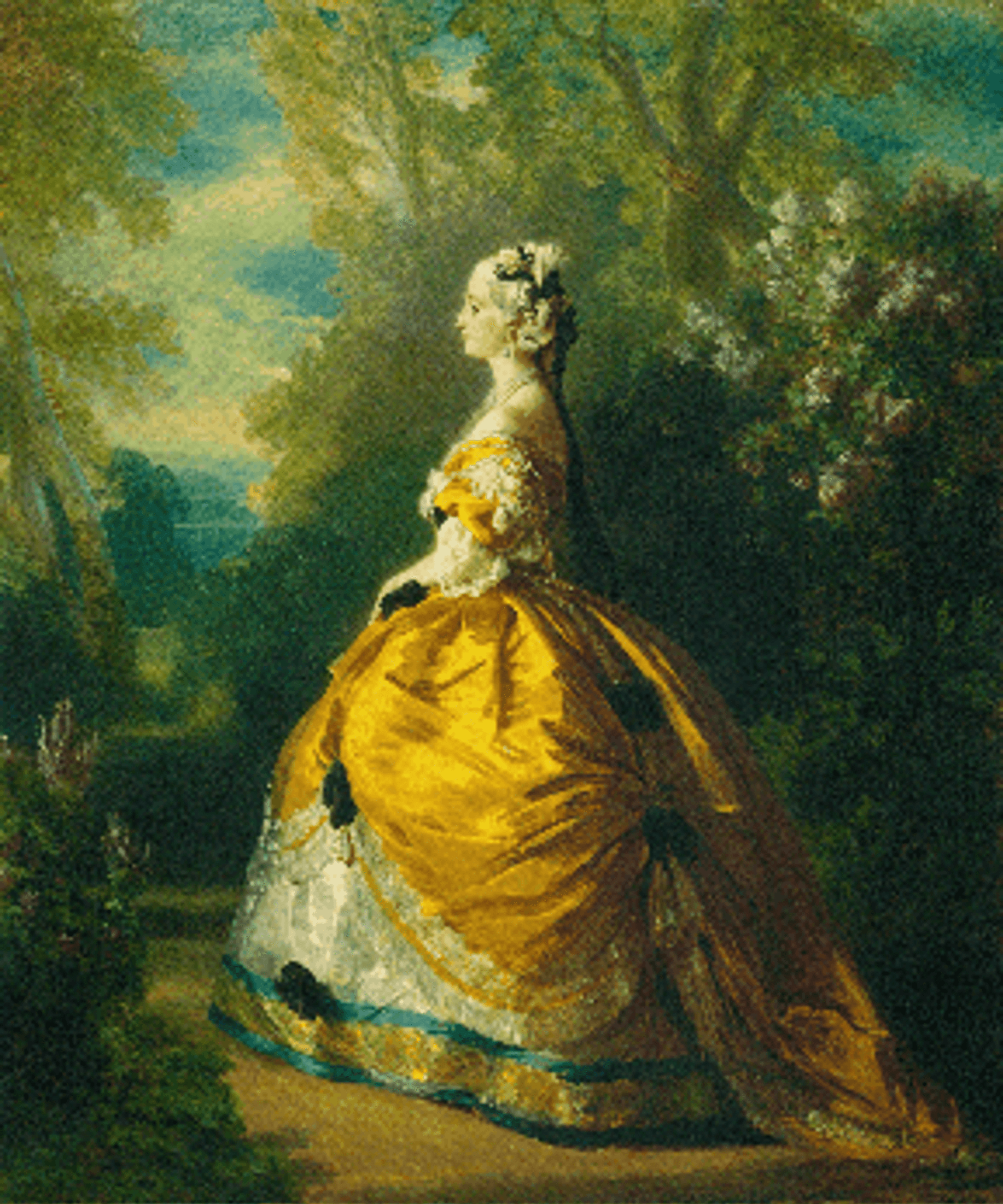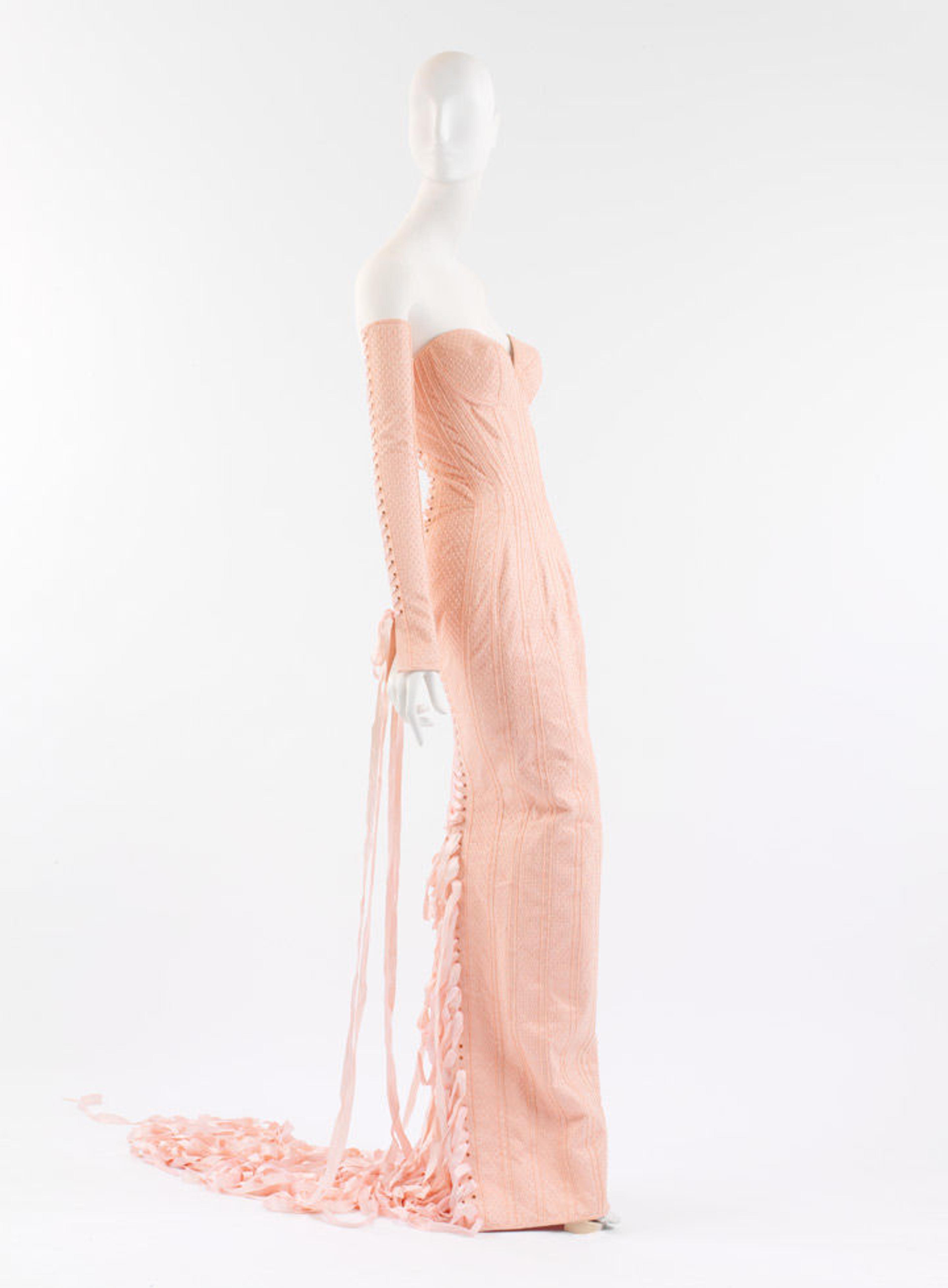
Royal Worcester Corset Company (American, 1864–1950). Corset, 1876. Cotton, metal, bone; Length at CF (a): 12 1/2 in. (31.8 cm). Brooklyn Museum Costume Collection at The Metropolitan Museum of Art, Gift of the Brooklyn Museum, 2009; Gift of E. A. Meister, 1950 (2009.300.3105a–c)
«Why does beauty always seem unattainable? Throughout history, young women have taken drastic measures to be considered beautiful. While fashion has always been a means for individual expression and society has broadened its definition of beauty, we still see judgment against women who don't fit an ideal. Through investigation and interpretation of 19th-century fashion, we can see the ways women have tried to meet past beauty standards and how those standards have evolved over time.»
By looking at an American dress from the 1850s, shown below, we can see a contemporary beauty standard for women. Judging by the expensive material and embellishments, the dress would have been worn by an upper-class woman. (In fact, the dress was worn by the wife of Former Rhode Island Governor William Warner Hoppin.) The dress is broken up into two parts: bodice and skirt. Under the dress, a contemporary wearer would have worn a corset that laced up in the back and hooked in the front and a hoop skirt, which would give structure to the dress. She also would have added jewels, lace pieces, and other accessories to complete her outfit.

Dress, 1850s. American. Silk. The Metropolitan Museum of Art, New York, Gift of Mrs. Frederick Street Hoppin, 1963 (C.I.63.7.3a, b)
Hoop skirts helped women attain a fashionable dress shape without sacrificing comfort. They were collapsible, which made for easy closet storage and (albeit limited) sitting, most likely on the top or edge of a chair. The style of the corset remained relatively the same into the 1860s, but hoop-skirt technology changed with the approaching decade. The invention of the crinoline in 1856 allowed women to add volume to their skirts without the added weight of eight to ten starched petticoats.

Royal Worcester Corset Company (American, 1864–1950). Cage crinoline, 1862–63. American. Linen, metal; width: 25 in. (63.5 cm). Brooklyn Museum Costume Collection at The Metropolitan Museum of Art, Gift of the Brooklyn Museum, 2009; Brooklyn Museum Collection (2009.300.2250)
With thin, steel loops sewn into a single petticoat, crinolines were much cheaper and lighter than previously used fabric and whale bone. As their mass production was perfected, the cost of a crinoline dropped from an estimated five dollars to two dollars and fifty cents, making it possible for both the lady of the house and her maids to stay fashionable.

By the mid-1860s, women were able to achieve a width of six feet in their skirt hems with the help of crinolines. The newfound ability to easily increase skirt size coincided with (and furthered) a changing fashion trend. It proved easier to add volume to the back of the skirt, as there was only so far to go in the front, and sometimes a separate but matching apron-shaped basque would be tied to the back as well.
Left: Franz Xaver Winterhalter's 1854 portrait of the Empress Eugénie shows the changing fashion trend toward a more elliptical, trailing silhouette. We created this GIF to give you a sense of the layers the empress might have been wearing beneath this dress. Image courtesy of the authors
Contemporary press made it seem like crinolines made simple movements like passing through a door, sitting on a couch, and getting in and out of a carriage very difficult, but these hardships were likely exaggerated in order to argue that women showed poor judgement. Amelia Bloomer, a women's rights advocate and proponent of dress reform, stopped wearing reform dress (a shorter skirt with loose trousers) after the hoop was introduced, in part because she found the hoop "light and pleasant to wear." While it is often difficult to separate the real and invented health risks of past fashion trends, it is true that women would do everything in their power to achieve a coveted figure despite the rumors of health risks and illnesses that resulted from altering one's body shape.
Today, the pressure to be a size zero, and then a zero-zero, is felt by teenagers and adults alike, but some modern designers reach outside of the limits of today's beauty standards to showcase a different take on beauty and fashion. Jean Paul Gaultier, an avant-garde fashion designer famous for constructing Madonna's cone bra, is a perfect example of how fashion is used in a more playful manner today. Gaultier believes that feminine beauty comes in many forms, which we can see in his use of curvy models and drag queens on the runway and the way he mocks absurd women's fashion trends in his designs.

Gaultier featured this haute couture dress in a show he called a compilation of his "greatest hits," which showcased clothes that resembled nudity. Jean Paul Gaultier (French, born 1952). Evening ensemble, spring/summer 2001. (A, b) silk, glass, synthetic; (c) silk, synthetic, leather; Length at CB (a): 56 in. (142.2 cm) Length (b, c): 21 in. (53.3 cm) Length (d, e): 9 1/2 in. (24.1 cm). The Metropolitan Museum of Art, New York, Purchase, Catharine Breyer Van Bomel Foundation Gift, and funds from various donors, 2001 (2001.455.2a–i)
Modern women continue to take drastic measures to achieve a look that meets current beauty standards despite an expanding definition of beauty in the 21st century. Designers like Gaultier are helping to change these standards, but we still have a long way to go. After close examination of the evolution of women's fashion, we don't have a definitive answer to how beauty standards for women started or why they still exist today, but it has been interesting to explore.